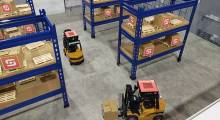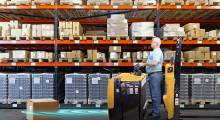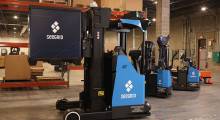Wearable robotics vendor Verve Motion, a Harvard University spinout dedicated to industrial worker safety, recently released the results of a four year study on wearable robotics in the workplace.
Verve said its research quantifies critical metrics related to back and hip injuries and demonstrates potential substantial benefits for industrial workers using soft exosuit devices, including a significant reduction in workplace injuries and enhanced worker well-being.
The study tracked ergonomics, safety, and injury metrics across more than 65 million lifts at over 40 sites in five industries: construction, food & beverage, logistics, manufacturing, and retail.
Verve said its findings offer insights into the impact of soft exosuits on physically demanding jobs where workers engage in rigorous, repetitive tasks, such as case picking, manufacturing, order picking, and shipping and receiving, routinely lifting between 10,000 and 60,000 pounds per day.
Majority of users report exosuits assisted their work
In selecting the variables to capture in the safety study, Verve Motion modeled its metrics on a 1995 study focused on ergonomics and occupational health. The 1995 study team analyzed over 400 industrial lifting jobs and identified several variables correlated with the risk of occupational-related lower back disorders, including lifting frequency, degree of forward bending, and twisting velocity.
“In conducting this data analysis, Verve Motion collaborated with customers across a number of sectors with the focus on metrics that matter most to them, particularly injury reduction, productivity improvement, employee well-being, and retention,” said Ignacio Galiana, Verve Motion CEO and co-founder. “We then analyzed how incorporating a soft exosuit ergonomically performed in environments that involved repetitive lifting, lowering, and bending - tasks performed hundreds or thousands of times daily.”
Among insights into workplace safety and productivity, the data analysis revealed:
- High-risk sectors and movements: The study identified the food & beverage, logistics, and retail sectors as having the most intense and least safe lifting activities, with employees averaging approximately 200 lifts per hour. Case picking was noted as the occupation with the highest lift rate, averaging 196 lifts per hour, with some sites exceeding 300 lifts per hour. More than 50% of these lifts involved deep lifts, with trunk flexion exceeding 40 degrees, and the heaviest loads exceeding 30,000 pounds per day on average. Dangerous movements leading to lower back and hip injuries were also highlighted. Bending at the waist accounted for 55-65% of all lifts, twisting for 20-25%, side bending for 10-12%, and excessive forward bending for 15-20%, all of which are well-known risk factors for injuries.
- Injury reduction: The use of exosuits led to a reduction in workplace injuries, ranging from 60-85% reduction per site. For example, at one distribution center which typically experienced one injury every 14,300 hours (roughly one out of seven full-time workers), the ongoing use of an exosuit resulted in just one injury every 94,000 hours, a 5.5-fold improvement (one out of 47 full-time workers).
- Reduction in unsafe movements: The soft exosuit not only provided lifting assistance but also encouraged safer movements. The study observed a 36% reduction in unsafe lifts among associates who wore the suit for five months or longer.
- Productivity improvement: The consistent use of exosuits resulted in an average productivity boost of 4.7%, with improvements ranging from 1.5% to 7.9% across the studied sites. Additionally, the worker productivity distribution became significantly tighter, indicating more consistent performance among workers.
- Positive workforce impact: The majority of users (97%) reported that exosuits assisted in their work, with strong positive sentiment (95%), reduced back muscle soreness (87%), less fatigue (79%), and increased job satisfaction (95%). Companies also reported higher workforce retention rates, underscoring the benefits of exosuit devices beyond physical safety.
Verve emphasizes the importance of strong safety culture
Verve said its study findings also underscored the critical importance of a strong safety culture and committed collaboration at deployment sites for the successful adoption of exosuits. The company said its research suggested that without these foundational elements, even the most sophisticated technology cannot reach its full potential in enhancing workplace safety. The analysis highlighted the necessity of cultivating a safety-first environment to effectively drive technological advancements and change.
“The data from this multi-year study confirms the transformative impact wearable robotics can have on reducing workplace injuries in high-risk industries,” Galiana said. “This emphasizes the exosuit's role not just as personal protective equipment, but as a catalyst for industry-wide change and sets a new benchmark for workplace safety and innovation.”
Back injuries are a major concern in workplace safety, affecting millions of workers annually. Occupational back pain is the most common type of injury reported, with more than one million U.S. workers affected each year, Verve said. OSHA estimates that the costs associated with back injury claims, including medical expenses and lost wages, range from $40,000 to $80,000 per incident.
SafeLift exosuit integrates with Verve Logic data analytics platform
Developed at Harvard's Biodesign Lab, Verve Motion’s SafeLift exosuit, which was used in the study, is a soft exosuit designed for industrial use. Tailored to each worker and task, the exosuit offers adaptive assistance by combining real-time motion sensing with robotic support.
It functions like a lightweight backpack, reducing back strain by about 40% during a typical workday and includes a cloud platform with sensors that detect risky movements, which can enhance injury prevention and workplace ergonomics through coaching. SafeLift’s inertial measurement units identify critical motions associated with back disorder risks, such as excessive torso bending and twisting, providing targeted support that decreases the workload on biological muscles.
Verve Motion recently introduced its Verve Logic data analytics platform at MODEX 2024. The Verve Logic platform integrates into the company’s SafeLift exosuit.
Article topics
Email Sign Up
















